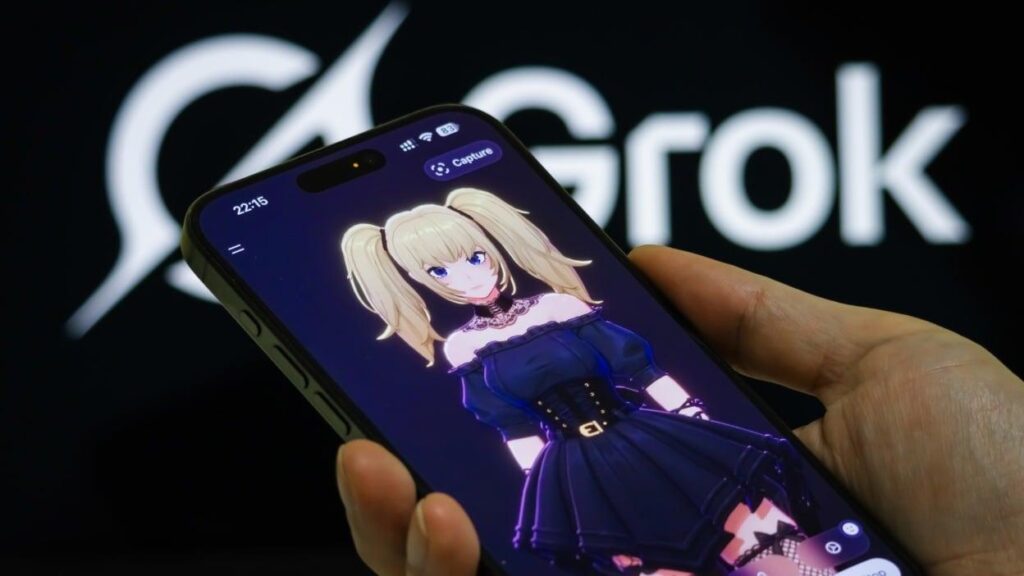- Grok Imagine 0.1 quickly and easily generates images and short clips with audio.
- The free tier imposes fees; higher plans unlock priority and full 15 seconds.
- Pay attention to limits, "Spicy" mode, and good safety and consent practices.

If you're thinking about turning a photo into a visually appealing clip, the combination of image and video with Grok has taken an interesting leap forward recently. xAI's AI It allows you to generate images from text or voice and, with the right tools, animate them in a matter of seconds. This is Our short guide to creating video images with Grok.
For months, many users have followed the typical workflow: create the image with Grok and then take it to an editor or an AI service to add motion and audio. The arrival of Grok Imagine 0.1 aims precisely to cut steps with the "image → short clip with sound" approachHowever, alternative workflows still exist for those who need more control, templates, or longer videos. Let's look at them in detail, step by step, keeping in mind limits, security, and practical tips.
What is Grok, how does it generate images, and what does Imagine 0.1 offer?
The generation of images of Grok It works very directly, like a chatbot: you type or dictate what you want and the system returns several versions to choose from. The interface is simple, with a “Create images” option visible below the text box, and allows for further refinements (more instructions, new styles and downloading the result to the device).
In addition to that core, the tool ecosystem around Grok It has stood out for several advantages that users value in content production: Speed, natural language control, high-quality export, various formats, and image animation to bring them to life. This mix makes it easy for the same project to work for social media, presentations, marketing, or pure entertainment.
In this context, Grok Imagine 0.1 appears, the beta version (as described by Elon Musk himself) launched at the beginning of August 2025. Imagine 0.1 combines image generation and short animation (up to 15 seconds) with automatically synthesized audio and prioritizes speed and creativity. Its agility and intuitive interface have been praised, although it has also received criticism for its "Spicy" mode (permissive NSFW content) and more lax moderation protections than the competition.
From a technical standpoint, public behavior suggests a two-stage channeling process: First text/voice → image; then, a motion module that infers temporal transformations, camera and sound layers to produce a short clip. This approach, inspired by xAI's Aurora framework and modern broadcast workflows, sacrifices millimeter-perfect control in favor of rapid iteration, which is precisely the value proposition of version 0.1.
The user experience is consistent: brief instructions, one-touch voice input, animation modes such as Normal, Funny, Custom and the aforementioned “Spicy”and a clear button to switch from image to video. After generating the photo, some reviewers have noted the presence of a "Create Video" button that triggers the animation with audio in a few seconds.

How to use Grok to create images and turn them into video
You can download Grok for iOS (App Store) and Android (Google Play) and log in with your X accountBy mid-August 2025, the Imagine feature will require the app to be updated (for example, to version 1.1.33 or higher). xAI has enabled free basic access globally, with quotas and limits, while the Premium+/SuperGrok levels They offer priority and expanded features.
In terms of availability, the main entry point today is mobile. Grok.com can be accessed from the web, but Imagine 0.1 is distributed first as apps.With X integration for a quick gesture: press and hold an image in a post and choose “Animate with Grok.” Full instruction-based generation—especially if you want to control styles—is best served within the Grok app.
Before starting, grant permissions to the photo library, because upload a reference image or animate your own photo It's part of the normal workflow. If the "Imagine" tab doesn't appear, classic tricks can help: restart the app, clear the cache, or reinstall.
Below is a guide in short steps to work with Grok Imagine:
Step by step: generate an image
- Install and open the Grok app (or use Grok within the X app). Access “Imagine” from the menu.
- Choose your input: text, voice, or upload an image. Describe your scene in detail. (lens, light, framing) or load a reference.
- Select style if it appears (realistic, illustration, anime, stylized art) and creation mode. The “Custom” mode adds refinement.
- Tap “Generate” and review the variations. Iterate with small changes to the prompt to direct the composition.
- Save the one you prefer on your device. You can continue varying and downloading as many iterations as you like. within your limits.
Step by step: convert image to video
- Create or select a base image from Grok. Click “Animate” from that image.
- Choose the duration (up to 15 seconds) and the animation mode. The system will automatically add ambient audio..
- Generate and preview. If you're not convinced, change the mode or adjust the prompt and try again.
- Download the ready-to-use clip for social media. For long clips, chain together: use the last frame as the basis for the next one..
- If you want advanced editing, export and finish in an external editor. CapCut or your favorite NLE fit very well.
Step by step: animating existing photos
- In “Imagine”, upload a photo from your gallery (for example, a portrait). Grok can automatically suggest a prompt.
- Choose an animation mode and press “Animate”. Let the system infer movement and audio chords.
- Save the resulting video. Edit or combine if you need more footage..
- Publish on X or wherever you prefer. Direct social integration to spread it quickly.
Quick prompting tips
- Be specific about lens, lighting, style, and mood. “Cinematic wide-angle shot at dusk, neon and soft rain” A better guide than "city at night".
- For photorealism, upload a clear reference. The supporting image helps to nail texture and anatomy.
- Iterate with small changes. A brief adjustment can greatly alter the composition..
- Keep in mind the creative autonomy of the model. Grok can add unsolicited elements in expressive modes.
Regarding tiers, the access model varies by version and region. Generally speaking, The free level limits image generation (e.g., 10–20 per day) and the length/number of videosIn addition to prioritizing the processing queue less, the Premium+/SuperGrok levels enable full 15s, advanced refinements, unlimited generation, and priority (faster during peak hours).

Limits, problem-solving, good use, and ecosystem
It is important to understand the limitations and variations of the platform. In certain free versions of Grok, image generation was capped at 10 photos every 2 hours.With a maximum of 3 image analyses per day; in more recent deployments of Imagine 0.1, the free limit is expressed as "10–20 per day" and includes reductions in video duration/number. These figures may vary by region or subscription level.
If the generation fails, there are several typical causes. Those under 18 years of age are not allowed to generate images In some environments, a poor connection can cause timeouts, or you may have used up your free data allowance. A quick browser/app update, restarting, clearing the cache, or simplifying the prompt often resolves temporary issues.
In terms of performance, the advantages of Imagine 0.1 are clear: speed of generation and accessibility (text or voice, and without cumbersome controls); direct social integration in X that facilitates "publish and go" functionality; and the convenience of converting an image into an audio clip without opening other software. On the "musts", The fidelity and cinematic finish may appear green At this stage, there is variation by platform/country/subscription and there are policy and security gaps, especially with the "Spicy" mode.
On this last point, xAI has opted for a more permissive approach than other providers, allowing erotic or sexualized material (not explicit pornography) in "Spicy" mode. This fuels both creative freedom and regulatory concerns, in addition to obvious risks of misuse (deepfakes, unacknowledged similarities) when photo uploads are combined with that mode.
How should creators and companies act? For the independent professional, It treats Grok Imagine as an idea generator and a social tool for quick clipsMockups, concepts, and viral pieces; for high-risk projects or serious editorial use, it includes human quality control and image releases. In corporate environments, it activates internal policies on compliance, intellectual property, and brand safety. Review any material involving real people or trademarks and avoid posting outings that could be mistaken for real identities without formal permission.

Video images with Grok: Key FAQs
- Can Grok generate videos from images? Historically not, but with Grok Imagine 0.1 you can convert an image into a short clip with audio (up to ~15 seconds). For longer videos or advanced editing, combine it with tools like Edimakor.
- How many images can I generate per day? It depends on the deployment and your skill level. In classic free versions of Grok: 10 images every 2 hours (resets throughout the day) and up to 3 image analyses per day. In the free version of Imagine 0.1, the limit is approximately 10–20 per day. With a subscription, these restrictions are either removed or significantly increased.
- Why isn't image generation working for me? Check the account age (not available for minors), unstable connection, exhausted quotas, or corrupted cache. Update the app/browser, restart, clear cache, and simplify the prompt. Reducing styles and parameters often helps.
- Is Grok free? There is a free tier with quota and feature limitations. The paid plans (Premium+/SuperGrok) add unlimited generation, processing priority, advanced modes, and full 15-second videos.
- What exactly is the free limit? Grok's baseline: 10 images/2 hours and 3 image analyses per day. Imagine 0.1 mobile beta: daily image/video limits (e.g., 10–20 images, videos with trimmed duration/quantity). xAI can adjust these limits.
- How do I "unblock" generation problems? Check quotas, update the app, restart, clear cache, and reduce prompt complexity. If the "Imagine" tab doesn't appear, reinstalling usually resolves the issue.
To complete the ecosystem overview, CometAPI deserves a mention: a unified API platform that integrates more than 500 AI models (GPT, Gemini, Claude, Midjourney, Suno, etc.) with consistent authentication and request/response formats. Their goal is to facilitate iteration, cost control, and vendor independence. They have announced support for the Grok Imagine API as soon as it is officially available; meanwhile, they invite you to try other image models—such as Seedream 3.0, FLUX.1 Context, or GPT-1 Image—in their Playground, with lower prices than the official ones and video generation options (including Midjourney) within its catalog.
Whether you're just starting out or already producing at a good pace, The key is to choose the flow that best suits your goalBrainstorm and publish quickly within the app with Grok Imagine 0.1, or combine Grok's powerful generation capabilities with editors like Edimakor to extend duration, add templates, and control every detail. AI lets you go from a phrase to a sound clip in seconds; the rest, as always, is up to your creative judgment.
Editor specialized in technology and internet issues with more than ten years of experience in different digital media. I have worked as an editor and content creator for e-commerce, communication, online marketing and advertising companies. I have also written on economics, finance and other sectors websites. My work is also my passion. Now, through my articles in Tecnobits, I try to explore all the news and new opportunities that the world of technology offers us every day to improve our lives.
